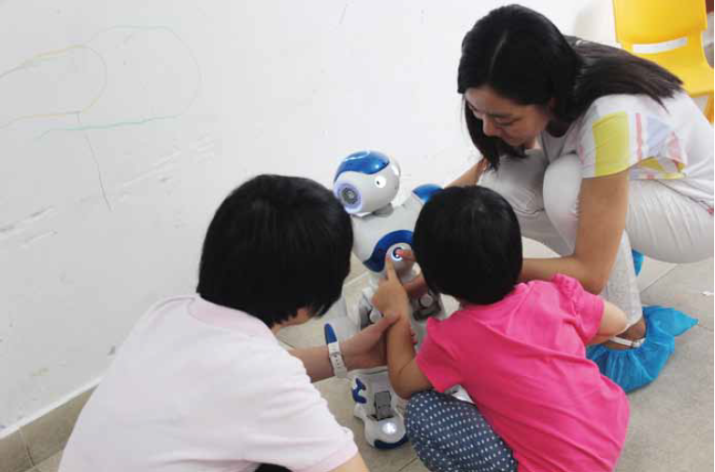|
|||||||||||
|
|
| Software and Soul |
| A startup helps autistic children learn life skills with a robot playmate |
| By Chen Ran | VOL. 8 JANUARY 2016 |
 |
| A child touches NAO for the first time with the help of Edith Liu (right) at the Golden Age Interventions Center for Special Children in Shenzhen, Guangdong Province |
Just one year ago, Edith Liu knew little about robots and was planning to follow her classmates and work at a Fortune 500 company after graduation. Today, the 25-year-old is the co-founder of a startup that has brought a French robot to China to help children with autism spectrum disorders (ASD). What a difference a year can make.
Liu's company, Open Source Maker Space, launched the robotic project, called A Machine's Soul, on the crowdfunding platform themakers.cn in September 2015. By the November 8 closing date, the company had received 858 likes on the site and raised 135,210 yuan ($21,290), surpassing their target of 120,000 yuan ($18,900).
The humanoid robot, NAO, stands 58 cm tall, and has mood recognition and interactivity capabilities, such as walking and talking. It is programmed to communicate with children with ASD in voices they are familiar with, such as their parents' or pediatricians'. Children can acquire and practice life skills through an interactive imitation game with the robot called Follow Me.
The original developers of NAO, Paris-headquartered Aldebaran Robotics, have an open source policy that allows other entrepreneurs to create their own applications for the robot. NAO is being used in computer and science classes in over 70 countries, according to the company.
Liu, who graduated from Audencia Nantes in France with an MBA, visited the Aldebaran headquarters in November 2014. Nicolas Xie, a 33-year-old telecommunication graduate interested in robotics - and who would eventually become her business partner - arranged the tour. Liu knew next to nothing about robots but the machines' human-like capabilities piqued her interest.
"I was totally fascinated by how intelligent NAO was. It was the first time I found a robot wasn't just a cold machine and was not that far removed from my life," she said. "It was friendly and approachable and could be a good companion."
"We made up our minds to introduce NAO to Chinese children with ASD because we would like to offer a new approach - a hi-tech one - to treat autism," Xie added.
ASD is a group of neurodevelopment disorders causing difficulty in communicating or social interactions and in some cases affecting the ability to think. Specific disorders include Asperger's syndrome and autism. According to a 2013 World Health Organization report, one child in about 160 worldwide has ASD and subsequent disability. In China, there are about 1.64 million children diagnosed with ASD.
In December 2014, Liu, Xie and Louis Lu, a former engineer at ZTE's European branch, established Open Source Maker Space in Shenzhen, south China's Guangdong Province. Liu and her team spent six months consulting experts, conducting field surveys and research, and designing solutions. They created a tailored application platform for teaching and learning based on NAO's hardware to enable one-on-one or group interactions between children with ASD and the robot.
Their key innovation, according to Liu, is a platform with a remote control that allows pediatricians and parents without any programming knowledge to control NAO.
"The ongoing assessment demonstrates that most children with ASD have a positive response to robotic-assisted rehabilitation," Xie said.
The company began collaborating with the Golden Age Interventions Center for Special Children in May 2015. Started in 2004, the center is one of the first non-governmental institutions in Shenzhen for autistic children.
"The children here are curious about the robot, which encourages their desire to communicate," said Wang Jing, a social worker at the center.
The initiative appears to be working. Some children recognized Liu after she visited the center several times for assessment sessions.
"I was impressed when a four-year-old hugged me and sat on my lap right away," Liu said. "A seven-year-old boy said 'robot' holding my arms. I was deeply moved."
Liu and Xie say the next step is determining how they should evaluate the treatment outcomes. Does the combination of artificial intelligence, medical theories and real-life applications meet expectations? There was one challenge. The human-robot interaction is interrupted if a child pushes NAO or fiddles with it. So Liu and Xie are seeking a bigger and heavier robot to counteract the problem.
"We need to spend more time on assessing if the treatment has improved," Xie said.
The project goes beyond helping individual patients. Lu said it has helped raise awareness of ASD.
"There are fewer than 3,000 professionals in rehabilitation training for autism nationwide. The involvement of robots will definitely lend them a helping hand," he said.
The company has promised to use all the money raised during the crowdfunding to improve the existing application platform. From this month, they will collaborate with an autism treatment center, choosing five families to design customized teaching content for their children, who have ASD.
"Now more people know about our project," Liu said. "Several ASD-affected families have contacted us. We have recognition and support from the government. It is far beyond my expectations."
|
||
|
|||
| Copyright ChinAfrica All right reserved 京ICP备08005356号 |